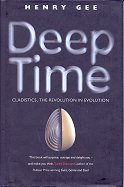Evolution takes place over a long time. A very long time. So long that we cannot really comprehend it. Popular writers try, by using such devices as pretending a million years of geological time is a "year". Then the earth formed 4500 "years" ago, fish moved onto land 360 "years" ago, dinosaurs became extinct 65 "years" ago, and H.sap arose about one "year" ago. This is all very well for understanding relative timescales, but we must not use it to fool ourselves into thinking we can place a human-comprehensible narrative on these "years". And the reason is, the thing that the analogy makers rarely emphasise, is that an entire human life-span is just 30 "minutes" on this scale. We simply cannot construct a meaningful narrative over these at first seemingly-comprehensible "years", when the characters each live for a mere half "hour".
Gee shows how these Vast expanses of time, "Deep Time", are qualitatively different from our own human-scale concepts of time. The fossil record, far from forming an unbroken chain from today back to our weird little ancestors, is no more than a few pitiful scraps of bone spotted here and there throughout Deep Time, with vast gaps between them. There is no way we can say any particular bone belonged to an ancestor, or even to an ancestral species. When we try to construct a human-scale narrative of evolution, we tend to see everything in terms of the animals and plants of today. And so we incorrectly reason from current form to adaptive explanation (yet it appears that fish evolved feet before they left the seas; birds evolved feathers before they started to fly), and worse still, we are unscientific, because these "Just So" stories are untestable, unfalsifiable. The best we can do is postulate a degree of cousin-hood, based on degree of similarity. And that is what cladistics does.
Gee provides an entertaining, informative and fascinating account of cladistics, the problem it solves, and how it solves it. He doesn't shy away from using lots of Latin names, but he also paints great pictures with examples from a box full of old unlabelled family photographs, to deducing the function of a unicorn's horn. And since he was personally involved in some of the early work, we get some nice little vignettes of the characters involved in introducing cladistics to paleontology. I would have preferred rather more pictures and diagrams, though.
I've never liked some of the popularisations of evolution, and this wonderfully accessible book makes me understand why that is, and also understand that it is possible to do real science in this area.

